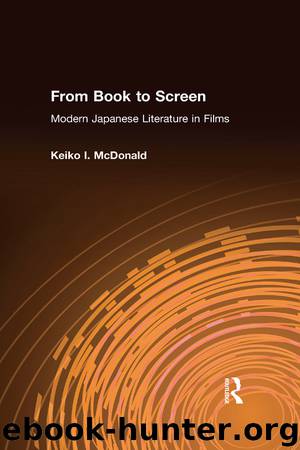From Book to Screen: Modern Japanese Literature in Films by McDonald Keiko I

Author:McDonald, Keiko I.
Language: eng
Format: epub
ISBN: 9781315292397
Publisher: Taylor & Francis (CAM)
Saki Takaoka (r) in A River with No Bridge (1992) by Yoichi Higashi. Courtesy of the Kawakita Memorial Film Institute. Hideaki stands at the top of the village heap, being the wealthy heir to the temple in Komori. He attempts to change his outcast status by leaving the village to attend high school. When his classmates discover his origins, he transfers to another school. The agony of deception continues when he falls in love with an outsider, the daughter of his art teacher. However, Hideaki’s values right themselves, as he learns from his failure to appear other than what he is. He gives his real self to a worthy cause, taking on a leadership role in Suiheisha.
Sumii’s narrative technique requires that Koji make piecemeal sense of all this village history. He is a child when Seitaro and Hideaki leave the village. He learns about their motives as a youth, through a kind of confessional testimony. Seitaro writes Koji a long letter. Hideaki tells his story at a public lecture held in the village temple. In other cases, the child Koji picks up bits of buraku history in passing, overhearing his mother and grandmother, for example, discussing Nanae’s case.
Koji turns out to be an apt and outrageous pupil, learning from buraku history enough to map out a course for his life. He decides to accept his eta status as “privileged.” He will work for his people by remaining rooted in Komori. Of course, this decision can only come about thanks to the community support offered by the foundation of Suiheisha (1922), whose manifesto declares “The time has come to be proud of our heritage as Eta.”
As might be expected, in order to reach this stage, Koji needs mentor figures. Throughout the novel, his uncle Kazuichi and friend Hideaki, by virtue of their education and affluence, serve as such for Koji, who has only a six-year elementary education. They “initiate” him into the outside world by updating him on major current events. They also introduce him to the world of literature. For example, in his childhood, he is given a magazine that contains a short story called “Toge no aki” (Autumn on the mountain pass) dealing with the love of two burakumin. This is his first exposure to a world of fiction in which discrimination is just as real as that which Komori residents experience. Other books that serve Koji’s awakening to ideals of freedom and equality are Shusui Kotoku’s autobiography and Whitman’s Leaves of Grass.
As we have just seen, Koji grows in response to experience with the division between insider-outsider in society as he knows it. One major causal line derives from Koji’s relationship with Machie, the affluent girl from outside. Koji harbors secret yearnings for her as early as elementary school days. His feelings combine the painful polarities of hope and fear. Throughout this novel, their relationship appears as that rare instance of the in-out division bridged, not through interclass marriage, but through understanding. Koji’s yearning for this impossible alliance is channeled into social activism.
Download
This site does not store any files on its server. We only index and link to content provided by other sites. Please contact the content providers to delete copyright contents if any and email us, we'll remove relevant links or contents immediately.
| African-American Studies | Asian American Studies |
| Disabled | Ethnic Studies |
| Hispanic American Studies | LGBT |
| Minority Studies | Native American Studies |
Cecilia; Or, Memoirs of an Heiress — Volume 1 by Fanny Burney(31321)
Cecilia; Or, Memoirs of an Heiress — Volume 3 by Fanny Burney(30927)
Cecilia; Or, Memoirs of an Heiress — Volume 2 by Fanny Burney(30884)
The Great Music City by Andrea Baker(21166)
We're Going to Need More Wine by Gabrielle Union(18063)
Bombshells: Glamour Girls of a Lifetime by Sullivan Steve(13099)
Pimp by Iceberg Slim(12922)
All the Missing Girls by Megan Miranda(12739)
Fifty Shades Freed by E L James(12442)
Norse Mythology by Gaiman Neil(11872)
Talking to Strangers by Malcolm Gladwell(11855)
Crazy Rich Asians by Kevin Kwan(8340)
Mindhunter: Inside the FBI's Elite Serial Crime Unit by John E. Douglas & Mark Olshaker(7827)
The Lost Art of Listening by Michael P. Nichols(6460)
Enlightenment Now: The Case for Reason, Science, Humanism, and Progress by Steven Pinker(6402)
Bad Blood by John Carreyrou(5760)
The Four Agreements by Don Miguel Ruiz(5502)
Weapons of Math Destruction by Cathy O'Neil(5027)
We Need to Talk by Celeste Headlee(4861)
